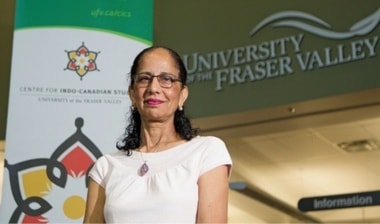SURREY — At the end of 2013, Canada was exporting more than $20.4 billion worth of goods to China. But Canada's trade with the other country that boasts over a billion people – 1.23 billion to be exact – is nowhere near the same.
Only $2.8 billion worth of Canadian exports were sent to India in 2013. While the South Asian country is second in global population, it's not even on Canada's top-10 list in terms of exports.
When it comes to goods coming the other way, India's $2.9 billion worth of exports to Canada in 2013 doesn't even place the country among the top 15 nations exporting to Canada, and is only a small fraction of the more than $52 billion worth of exports sent our way from China that year.
“I think the imagination of India has not yet crept into Canada,†said Satwinder Bains, director of the Centre for Indo-Canadian Studies at the University of the Fraser Valley. “I feel it hasn't really matured. This idea of trade with India has not yet become fully sophisticated; businesses haven't come forward and said they want into this.â€
So is Canada missing a subcontinent-sized opportunity?
Bains said that while the short answer is yes, it's a complicated issue with many factors in play. She noted the highly bureaucratic business culture and concentration of power in India has hampered growth.
“There are only a handful of conglomerates who control the larger business sectors, and they have over time built tremendous relationships all over the world as well as in India. So infiltrating that is difficult. And small and medium-sized businesses, they're much more difficult in India because … the market is very split. There's the very wealthy, there's the very poor, there's in between – there's a burgeoning middle class that's becoming more and more sophisticated. So I think it's quite complicated in terms of access to Indian business and bilateral trade.â€
Bains noted that while China is a largely industrialized nation, India is still developing as a world power, with its enormous workforce as its main asset.
Yet the key to unlocking this potential with India may lie very close to home, says Surrey Coun. Tom Gill. Surrey's robust South Asian population – more than 30%, according to the latest Statistics Canada numbers – creates a unique opportunity, Gill said.
“I think one of the things that is going to materialize, and given the South Asian population in Surrey and mentality, is that many South Asians are entrepreneurs and self-employed. And they have significant connections to home. And particularly I'm referring to that first-generation immigrant that's come over to Canada and been successful and really wanting to be able to invest back in India.â€
Gill said many of those first-generation immigrants are now approaching retirement and are looking for a place to invest their hard-earned cash. Both Bains and Gill note that India's economy is largely relationship based, meaning a high percentage of small and medium-sized businesses are passed down through generations.
The devaluation of the rupee, which has been steadily dropping since 2010, provides unique opportunities for Surrey business owners with direct ties to India, Gill added.
“It just makes it that much more valuable for an individual wanting to capitalize on that particular market – wanting to use the rupee as a leveraging pin to be able to look at other global opportunities for products and manufacturing.â€
When it comes to strengthening trade ties with India, Bains said part of the burden should fall on the federal government to do more.
During a speech at a July Surrey Board of Trade event, International Trade Minister Ed Fast stressed the importance of fostering trade with India, especially in light of the recent election of Prime Minister Narendra Modi, who many believe is more pro-business than his predecessor, Manmohan Singh.
“India is of course the world's largest democracy and of course is expected to become the world's most populous nation, passing even China,†Fast said. “And it is imperative that your federal government take a special interest in India. And that is why India has been designated a priority country in the Global Markets Action Plan.â€
One sector where closer ties have already paid dividends in Surrey is higher education. In January Simon Fraser University joined with Ryerson University to develop an “incubator†in collaboration with the Bombay Stock Exchange Institute. The program aims to help entrepreneurs fast-track their startups in both Canada and India. In 2006, the University of the Fraser Valley set up the Centre for Indo-Canadian Studies, which looks to capitalize on India's middle-class youth hoping to study abroad. Right now, half of India's population is under 25. That statistic is similar to the situation in Surrey, where one in three is under the age of 19. Bains said many of those Indian students are looking not only to study abroad, but also to eventually live and work abroad.
“India is under stress and struggling to be able to provide good, viable jobs for their graduates and their people who are educated,†she added. “That is still a dilemma, because it has always been such an entrepreneurial country and because it is so diverse, and such a stratified economic base.â€
For more stories from Business in Vancouver, click here.
